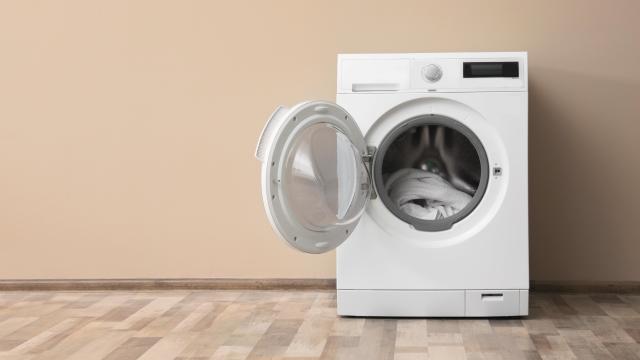Have you ever opened your washing machine only to be met with a foul, funky stench? Did you shrug and ignore it? Me too. But it got worse, didn’t it? Until eventually, your newly washed clothes smelled like mildew. We both had mould and bacteria growing in our washers and befouling our laundry. Luckily, it’s fairly simple to clean your washing machine and prevent the mould from growing back.
Why is there black mould growing in my washing machine?
Mould loves moisture, and there are parts of your washing machine — gaskets, seals, hoses, dispensers, etc. — that get wet and never fully dry. Mould also feeds on leftover fabric softener and detergent traces left behind when you’ve finished washing your clothing.
While mould can grown in any washing machine, those in humid places, front-loading, and “high efficiency” washers are more prone to mould buildup than top loaders. When you close the door an HE machine, it seals, preventing air from circulating and leading to mould. But an even worse problem can come from the rubber seals that keep everything in an HE washer airtight. Mould builds up underneath them if you’re not meticulous about cleaning and drying them regularly.
Is washing machine mould dangerous?
In a word, yes. “Mould that grows in washing machines can be problematic even when the machine is not in use,” Melanie Carver, a spokesperson for the Asthma and Allergy Foundation of America, told Consumer Reports. “Mould can trigger allergic symptoms — including sneezing, itching, runny nose, and congestion — and can also be an irritant to the airways.”
Luckily, there are simple ways to clean the mould out of your washer, and prevent it from growing back.
How to clean the mould from your washing machine
To clean your washing machine of mould, first gather the following supplies:
- A bucket
- Rubber gloves
- An old towel or rag that you don’t need anymore
- A brush
- Mould-killing solution
Make a mould-killing solution
There are commercial products designed to kill mould, but there are lots of things you probably already have that you can mix with water to destroy mould too — the tried-and-true is chlorine bleach. To make a bleach-based mould-killing solution:
- Mix 1 part bleach with 4 parts water.
If you don’t want to use bleach, you can try these alternative recipes:
- 2 cups water, ½ cup hydrogen peroxide, and ¼ cup lemon juice
- 2 cups water, ¼ cup lemon juice, and ½ cup distilled white vinegar
- 1 part vinegar and 4 parts water (I haven’t found vinegar cleaning solutions to be particularly effective, but your mileage may vary.)
Important: Do not mix bleach with any of these other ingredients, as it could create a deadly gas.
Step 1: Clear out the washing machine’s pipes
Mould can build up in the tubes and pipes of your machine, so first, we’re going to take care of that by following these steps:
- Empty the washing machine, and make sure there’s no leftover detergent or fabric softener in the dispensers.
- Pour about a cup of straight chlorine bleach into the washer’s main drum, or…
- If you have a detergent, softener, and/or bleach dispenser drawers, pour a reasonable amount of bleach, depending on the size of your machine, into each of them.
- Run the empty washer at its hottest water cycle and largest load size.
- Leave the door open so it dries thoroughly.
Step 2: Clean the inside of your machine
- If you have a front loader, make sure you peal back the seal, and using a cloth or a brush, clean behind the rubber gasket thoroughly
- Wipe down the drum, lid, and all exposed parts with your mould killing solution and your towel, making sure you’re wearing gloves.
- Dry it off with a dry cloth and leave it open.
- If you want to get ambitious, you can remove the entire drum from inside the machine and wipe everything down. Consult the manufacturer for whether this is possible/advisable for your particular washing machine.
Step 3: Clean the lint trap and dispensers
Many washing machines have removable dispenser drawers for detergent and fabric softener.
- Check the manual to see how to take them out.
- Soak them for an hour or so in hot tap water.
- If you can’t remove the drawers, clean them by wiping them down with a brush or rag soaked in your solution.
- Dry everything thoroughly before you put it back in place.
Most washing machines have a lint filter or trap, and this is often a huge mould attractor. Check uour manual for how to remove it. Once you have:
- Clean out any accumulated gunk on the trap.
- Scrub it down with your mould-killing-solution or soak it in hot water.
- Run a wash cycle with no detergent or bleach to make sure everything is fully flushed out.
How can I prevent mould from forming in my washer?
Now that your washer is mould-free, there are some steps you can take to help prevent mould from forming again (or at least slow its growth).
- Always leave the washer open between uses.
- Leave dispensers open as well, if you can.
- Don’t leave wet clothes in your washer.
- If you have a high efficiency washer, only use detergent designed for HE machines.
- Again, for HE washers, make sure you dry the area under the door gasket after every use.
- Improve the air circulation in your laundry room with a fan or open window.
- Run a dehumidifier to take moisture out of the air.
- Avoid using too much detergent.
- Some people recommend ditching fabric softener altogether, and using white vinegar instead.

Leave a Reply
You must be logged in to post a comment.